
W T Teagle
1911–89
In 1930 at the age of 19, William Thomas (Tom) Teagle was left to run the 300-acre family farm, Tywarnhayle, near Blackwater, six miles North of Truro, after his father purchased another farm in the St Columb area and moved there with the rest of the family.
Tom demonstrated a natural ability for making things, and began building machinery and equipment, first for his own use on the farm but, within a few years, he was also building farm carts to sell to other local farmers.
During the potato planting season of 1941, Tom developed an original concept of a potato planting machine that also applied fertilizer around the seed potato within the planting operation. The effectiveness of this mechanism was considered of such national importance in wartime that the Agricultural Executive Committee commandeered the design along with its component parts, and commissioned Denings of Chard to manufacture the equipment. Teagle however received no payment from the government or royalties for use of the design, so after the war he put the planter into production himself, and advertised it for sale as ‘patents pending’.
As business grew, all the farm buildings were taken over for equipment manufacture, the barn became an assembly area, the Dutch barn turned into a fabrication shop, and a redundant prefabricated aircraft hanger was purchased and moved to site to increase the factory area, meanwhile the fields around were sold to neighbouring farmers.
Teagle’s farm had become a factory!
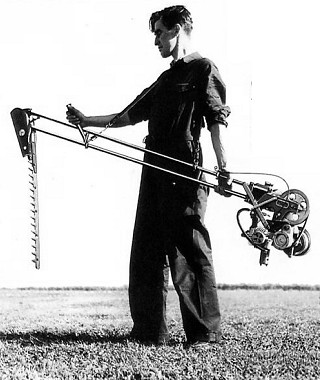
Other new equipment designs joined the Teagle machinery range, a steerage hoe for the very common Fordson Standard N tractor, and the world’s first spinner broadcaster with adjustable spreading control for granular fertilizers. The demand for this equipment quickly exceeded Teagle’s production capability, so several other small Cornish engineering companies were subcontracted to supply components.
By the early 1950s it was becoming apparent that there could be a potential market for lightweight and portable powered horticultural machinery. At this time, such equipment barely existed, and laborious tasks like cutting back thorny livestock hedges had to be painstakingly performed by hand, so Tom Teagle set about designing a portable powered hedge cutter. The first ‘Jetcut’ hedge cutter prototype was built in early 1952 using a Trojan Mini-Motor to test the concept, but its heavy engine with cast iron cylinder quickly convinced Teagle that a lighter engine would be needed, so he decided to make his own. The result was a remarkably light all-aluminium motor with a die-cast one-piece crankcase & cylinder outrigger casting and, because the engine was intended for power tool applications, it was built with fan-cooling right from the start, with blower air directed through a cast aluminium shroud. The Jetcut hedge cutter with Teagle’s own engine went into production in 1952 with a ‘square’ bore and stroke of 40 × 40mm, which seemed to have been given as 49cc, but we calculate it to 50.25cc. While neither compression nor power output figures were quoted, the specifications listed 3–4,000rpm as normal operating revs, and 9,600rpm as the maximum, which would seem quite remarkable for a deflector-top piston design!
Then in a moment of reverse thinking, since the prototype Jetcut was originally powered by a Trojan cyclemotor engine—why not now use the hedge cutter engine to power a cyclemotor?
Tom Teagle drafted drawings for the proposed cyclemotor design, and presented them to the Motor Cycling magazine stand at the 1952 Earls Court Motor Cycle Show, proposing a fan-cooled version at £16, and an air-cooled version at £14. Stone & Cox rather over-anticipated the reality of testing and delivering a cyclemotor into production, since they ‘jumped the gun’ and listed the Teagle cyclemotor as available for sale in 1953 at a retail price of £14. The Teagle didn’t actually become available till somewhat later… The first road test of the engine in Power & Pedal magazine wasn’t published until May 1954, following which the Teagle cyclemotor finally went on sale.
Two versions were described in the manufacturer’s instruction manual, being Standard Model A (atmosphere cooled), and Super Model B (blower cooled).
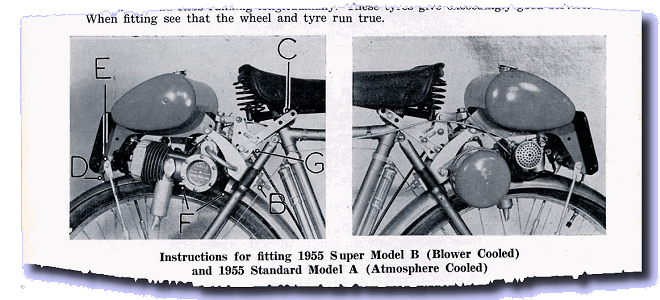
Illustrations of the Standard A show the photographic model fitted with a (cheaper) BEC carburettor on the left-hand side of the bike, while Super B illustrations demonstrate an Amal carburettor on the right-hand side, mounted on a long rubber induction pipe. There is no evidence however that the air-cooled Standard A version ever progressed much beyond the prototyping stage, and only the fan-cooled Model B seems to have entered production.

Our Super B example is mounted on a Raleigh 23" Gents frame, with Webb sprung fork set, a three-speed hub, and Radnell’s pattern calliper brakes. Sparks are provided from a Wipac Series 90 magneto set, which also contains its own lighting generator coil. This engine has been post-fitted with a different type BEC (Bletchley Engineering Company) carburettor, right-hand mounted on the end of a long rubber induction pipe (original equipment would have been an Amal), but the BEC seems to work just as well (possibly it’s from a ‘New Standard’ Power Pak cyclemotor, which was also 50cc, so the jetting would have been reasonably compatible).
For starting, fuel on, pull the lifting lever to flood the reserve chamber in the carburetter, pedal up the road and grab the grip-lock lever on the left-hand bar to engage the drive roller and get the engine spinning, then twiddle the throttle lever to encourage the motor to start. When you’ve got the motor to catch, you can release the grip-lock to disengage the drive, and then keep it running on the throttle lever to warm.
The Teagle engine is fan-cooled and employs the same cast aluminium cowling as all the other Teagle engine versions of Jetcut, though the cyclemotor shroud is distinctively fitted with a triangular badge fixed off three bosses which ordinarily mounted the recoil starter in other applications. The badge prevents people putting their fingers through to the spinning magneto flywheel behind.
The engine lifter mechanism lever works like a clutch in reverse, so pull in to engage the drive, which locks in five pressure latching positions. Though operation of this device can take a little getting used to, it can be useful in that you can lock-on only the minimum amount of roller pressure required under the prevailing conditions at the time. The advantage of maintaining minimal roller pressure is that the engine bearings are less loaded, and the motor will run quicker, quieter, and more economically.
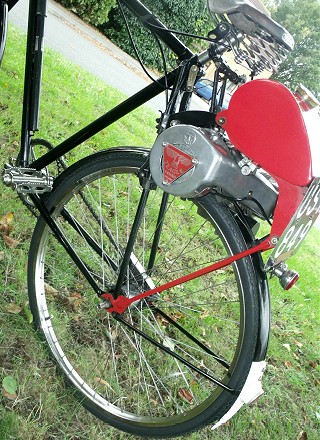
Under dry conditions on the flat, a motor may operate happily on a very light setting without slip, but come to a hill and putting on the power to climb the incline would increase the required load on the drive roller, so you click the pressure on by another notch. In wet conditions, the roller may more readily slip, so you may click on the pressure by a further notch. When however you may want to reduce the set pressure again (when you’ve got to the top of a hill), it’s quite difficult to control release of the lever to drop it back a single notch, because you’re fighting against a strong return spring at the motor end of the cable. Generally it’s easier to release the lever right back to disengage the engine completely, and then latch back up to the required pressure.
This also means that you won’t want the revs screaming when the engine disengages, so you would need to shut down the throttle. The operation is rather like a conventional gear change, where you shut down the throttle to pull in the clutch and change gear, except the clutch lever works in a backwards action.
If you’re unfamiliar with this operating arrangement, then it’s surprisingly easy to get in a mess with it. Forget to throttle down when you release the clutch grip-lock, and the engine revs scream as the motor disengages, but if you react by pulling in the clutch lever again, the drive roller just spins wildly and gnarls at the tyre, or the engine stalls … either way, you’re going to look a total klutz to passing pedestrians. A rider really has to think about the control operations.
The overhung crank design, with Torrington roller big-end bearing, and a long crank journal supported by large bearings results in surprisingly little vibration, so the motor is smooth running with no four-stroking once warm.
Open the throttle lever and the motor delivers strong torque, and builds up to speed well. Shutting down the throttle and unlatching the grip-lock lever gave a useful clutching function to allow you to keep the engine running for pulling up at junctions or having to stop in traffic, and then you’d find yourself trying to balance the tick-over until taking off again. Latching back in the drive was best effected by pedalling off to engage the motor when moving, then throttling up, but that reverse operation grip-lock clutch really does take a bit of getting used to.
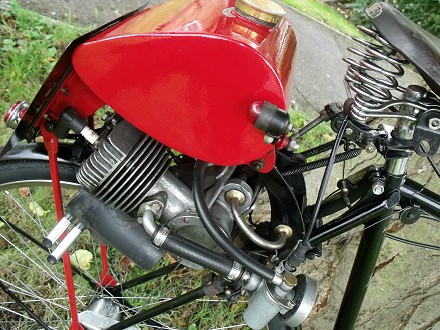
In terms of performance, the Teagle has bags of go. Its power comes in strongly like very few other clip-on motors of its generation. Straight away you can feel that Teagle is a king of its class, and could confidently see off almost any other cyclemotor.
Our pacer’s sat-nav clocked Teagle holding a rock steady 31mph along the flat in still air! That really is going some for any cyclemotor.
Come to a hill, click on the latch pressure another notch, then pile on the throttle, and Teagle will tackle that incline with a gutsy determination that few other cyclemotors can find.
When weighed in against comparable rear-mounted cast-iron heavyweights like the Trojan Mini-Motor or Power Pak, the Teagle all-alloy motor does seem remarkably light, but feels somewhat clumsily overhung behind the saddle, and might be worryingly vulnerable to damage if the cycle fell over, so secure parking is probably a sensible precaution to consider at all times.
A later Model-C fan-cooled Teagle cyclemotor presented a simpler mechanism to engage the drive by a long spring lever-arm engaged into a toothed plate that clamped on the saddle stem. This allowed more and even finer engagement positions to adjust roller pressure and was set by a handle in the diamond of a gent’s crossbar frame, though would prove rather obstructive in a ladies step-through frame, so the grip-lock control option remained available if preferred—we’d much prefer the Model-C lever set please.
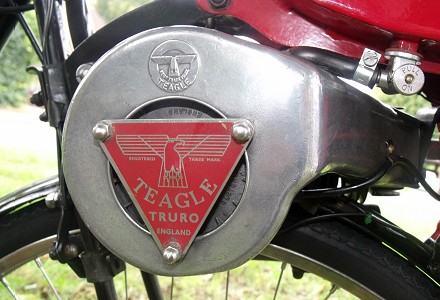
One could really imagine the Teagle on a racing cycle frame with drop handlebars, down in a tuck at full throttle, and reaching down with a left hand to tweak fine adjustment pressure of the roller to tease out that little extra performance. Teagle claimed that test rigs running their motors had registered over 9,000rpm, so maybe that daydream could really be a reality.
Other horticultural machinery using the same motor followed the Jetcut hedge cutters and the cyclemotor: Jetscythes, a Jettiller and Digo garden digger/rotavator. The demand for further heavy-duty powered horticultural equipment led in 1955 to development of the Teagle-B2 126cc side-valve stationary engine for further applications requiring more power than the 50cc two-stroke.
All the increased activity in agricultural and horticultural areas began to leave the Teagle cyclemotor increasingly marginalized among the volumes of factory production. Cyclemotor sales that were never in particularly significant numbers to start with, began declining rapidly in response to the increasing popularity of newer moped designs.
The Teagle really came along just a bit too late, in the summer of 1954, to catch the cyclemotoring wave, and by the time it did become available, that market was already just starting to ebb.
Power & Pedal magazine was still publishing Teagle clip-on advertisements into later 1956, but demand and sales were rapidly dwindling away as a developing social affluence was moving away from basic economy transport.
Final listings of the Teagle cyclemotor ceased after 1959, though the engine still continued to power its horticultural cousins for a few more years beyond.
Tom Teagle died in 1989, aged 78, but the Teagle Company still continues as a successful family business producing agricultural machinery.

